Tags
Cable, Competition, content, DISCA, DISCK, Discovery, John Malone, malone, OTT, Pay-TV, Strategy
For years, even as the Internet razed much of the profits at newspapers, magazines, books, and music labels, cable-TV networks kept making big money. More recently, as consumers shifted their viewing time from live television to various on-demand options, anxiety has risen. The standard subscription cable- or satellite-TV bundle—so lucrative for so long for TV programmers —is under assault. At the same time, cable distributors are more dependent on selling speedy Internet access and less dependent on pay-TV. Further, media reports are filled with stories of cord-cutters, cord-shavers and even cord-nevers. Are the good times over? Amidst all this uncertainty and negative news, how can we rationally forecast future cash flows for a cable network?
Discovery Communications (DISC)
DISC is an aggregator of non-fiction, non-scripted programming. It packages this programming into a portfolio of networks, including the Discovery Channel, TLC, Animal Planet and others. (See Figure 1) DISC has more than 1.5 billion subscribers around the world.
Figure 1
Source: DISC Investor Presentation May 2015
DISC compares very well to its competitors on both an OIBDA margin basis and a revenue CAGR basis. (See Figure 2 and Figure 3.)
Figure 2
Source: Company filings and my calculations
Figure 3
Source: Company filings and my calculations
The Traditional Pay-TV Industry Landscape
The traditional Pay-TV structure in which DISC operates is a cozy oligopoly made up of three parts.
The process begins with Content Creators. Content Creators are the production studios that actually create the programming to be televised. The content includes movies, serialized television shows and single event television. Examples of content creators include: Lions Gate, Paramount (a division of Viacom), and Warner Bros. (a division of Time Warner).
The next link in the chain are the Aggregators. Aggregators aggregate the programming produced by the Content Creators for viewing by consumers. This aggregation takes the form of networks or channels. Aggregators included traditional broadcast networks like ABC (a division of Disney), CBS and NBC (a division of Comcast) as well as cable networks like ESPN (a division of Disney), MTV (a division of Viacom) and the Discovery Channel (a division of Discovery Communications). Newer business models like the subscription video on demand model (“SVOD”) employed by Netflix also fit into this category .
Finally, Distributors deliver television content to consumers. Distributors (also known as “multi-channel video programming distributors” or “MVPDs”) are traditional wired cable service providers (e.g., Comcast, Charter, Time Warner Cable), satellite service providers (e.g., DirecTV, Dish) and telco TV service providers (e.g., Verizon FiOS TV, AT&T U-Verse TV). They purchase programming on a wholesale basis from Aggregators. They then make available for purchase, by subscribers or customers, multiple channels of video programming. These companies’ distribution activities included acting as the interface with customer including billing and maintenance issues, advertising the service, and providing both the hardware and software for viewing the programming.
The pay-TV value chain is characterized by high levels of vertical integration. The first two links in the chain, content production and aggregation, are frequently housed under a single roof. Disney, for example, produces content and owns various Aggregators including ESPN and ABC. There are very few independent Content Creators of any scale.
The Wholesale/Retail Relationship
The wholesale/retail relationship between Aggregators and Distributors has three distinct features that combine to create a walled garden within which they operate.[1]
The first feature is that the cable companies effectively have a local monopoly. In most communities in the US they operate without competition due to the huge costs involved in constructing a competing cable system. Further, a new cable competitor would have to entice customers by entering a price war, erasing any potential profit. Verizon and AT&T actually tried this but found that fiber-optic cable was profitable only in the most dense, urban areas.
The second feature is that the Aggregators had no interest in the customer service side of the business. They were content to have the Distributors deal directly with the customers.[2]
A third feature of the pay-TV industry is the big bundle. Multi-network Aggregators sell their programming bundled together on a wholesale basis to Distributors. That is, Aggregators with requisite leverage are able to force Distributors to acquire both their most popular channels and their least popular channels in one big bundle. DIS, for example, discovered some time ago that the must-have sports programming on ESPN gave them significant leverage with Distributors. They have the leverage to add channels and negotiate for higher monthly fees from Distributors, which are passed on to viewers. As a result, the DIS bundle features the stations owned by ABC, as well as the Disney Channel, Soapnet and seven national ESPN channels. ESPN also commands the highest per subscriber fee from Distributors. The DISC US bundle consists of 12 channels.
The result of the big bundle is that every subscriber is cross-subsidizing someone else’s viewing preference, with sports viewers being the main beneficiaries. Barely-watched national and regional sports channels are continually added to the basic tier and fetch licensing fees that are far higher than those collected by highly rated channels.
The walled garden led to a rapid rise in licensing fees. Over the past 15 years, Aggregators have greatly increased the fees they charge distributors to carry their programming. In 2000, advertising comprised 55% of the Aggregators’ revenue. Today, licensing fees make up the bulk of their revenue.[3]
Distributors then have to pass those higher costs along to their subscribers or accept lower profits on video. And for many years, the Distributors simply passed along all of these increased programming costs. (See Figure 4.)
Figure 4, Increase in Cable Subscription Fees vs. Inflation
Internet Driven Disruption – Down Come the Walls
As so often happens, the Pay-TV industry players got fat, dumb and happy and sowed the seeds of their own destruction. Content inside their cozy walled garden they allowed the following to happen:
- The big bundle got more and more bloated. Most consumers watch only a small fraction of the channels they receive. The average US TV home now receives 189 TV channels and watches 17.[4] This leads to frustration and a search for cheaper alternatives.
- Cable subscriptions rose much faster than the rate of inflation. This is mainly driven by Distributors passing along increasing costs for programming, particularly sports, but is not sustainable.
- The Distributors, particularly the cable companies, provided a horrible experience for customers. Among other problems, the Distributors stuck with a linear viewing experience when consumers have long made it clear they prefer to watch on their own schedule. The software interface that consumers are forced to navigate through is clunky, complex and confusing. The remote controls that are provided are complicated. This is before we even get to the horrors of arranging a service call.
- HBO, a unique and valued property, was made available only in addition to an expensive cable bundle.
Over the past five years, more than three million American homes have canceled their cable subscriptions while plenty more have signed up for online streaming services to control when, where and how they watch their favorite shows. (See Figure 5.) Now, some of the biggest players in television are looking beyond cable by offering services that bundle and stream programs without a cable or satellite hookup. In particular, NFLX showed that a company could combine aggregation and service in a single business model and go straight to consumers and by-pass the MVPDs (of course, the cable companies still get their cut). NFLX was able to come in under the high pricing umbrella created by the Aggregators/Distributors and provide a great value for consumers. Hulu and Amazon Prime then followed the path blazed by NFLX.
Figure 5, US Cable Subscribers, 1991-2015
Source: FCC reports, Wikipedia
The pace of change is now accelerating. Recent developments include:
- In October 2013, Comcast began offering an “Internet Plus” package of HBO, fast broadband and local channels for $40 a month, and
- In October 2014, AT&T started selling a similar $49-a-month bundle that also includes Amazon.com Inc.’s Prime free-shipping and streaming-video service for a year
- October 2014, CBS launces CBS All Access, making available thousands of TV episodes on-demand as well as live streaming for $6 per month without a cable subscription.
- On February 9, 2015, Dish Network launched Sling TV. The basic Sling TV package costs $20 per month and includes 22 channels. Most importantly, this package includes ESPN and ESPN2.
- On March 18, 2015, Sony Corp. began offering its PlayStation Vue streaming television service in New York, Chicago and Philadelphia. The most basic package is $50 per month for 50+ channels. It does not include ESPN.
- In April 2015, Verizon Communications , the No. 6 US pay-TV operator, began selling Custom TV, a $55-a-mont package of 45 base channels, plus a customer’s choice of two small collections of entertainment, news, sports, or kids’ offerings. The sports tier includes ESPN and prompted a lawsuit from Disney.
- On April 7, 2015, Time Warner launched HBO Now. HBO Now is an OTT subscription video on demand service. It is available as an a la carte offering to broadband subscribers. A pay-TV subscription is nor required.
- Apple is working on an Internet-TV service with some 25 channels, which is expected to be priced between $25 to $35 a month
- Second Quarter 2015, Comcast hit a major turning point when the number of people who subscribed to its Internet service surpassed its total video subscribers for the first time.
Impact on the Ecosystem
Where is this all heading? It is notoriously difficult to predict the future, but a few things seem certain.
- From Push to Pull – User control of content will continue to increase. (See Figure 6.) Power has shifted from institutions to the individual. The consumer, not the cable company, will control what they watch, when they watch it, and where they watch it. The linear live TV model, where content is consumed on someone else’s schedule, is dead. The big bundle model, where consumers are forced to subscribe to 200 channels to get the 17 they want, is dead. Customer experience generally is more important. Future winners will make it easier to discover the content we want via curators, editors and recommendation algorithms.
Figure 6
- Demand Remains High – There is little doubt traditional television, and the way it is distributed, is evolving. But demand for high quality programming (scripted and unscripted, live and taped) remains high. Americans spend more time watching TV than all other leisure activities combined.[5] (See Figure 7.) As the eminent futurist Irving Wladawsky-Berger (no relation) wrote on his blog earlier this year: “(I)t’s now much less clear what we mean by the TV industry, let alone what it’s future might be. Just about all aspects of the industry are being massively restructured, and its companies must keep embracing technology innovations while searching for viable business models. At the same time, the future of TV looks quite positive, – perhaps even golden, especially when compared to other industries within media.”
Figure 7
- The Changing Nature of Competition – Unbundling will change the nature of competition among the Aggregators, by forcing the networks to directly compete for subscribers or for a spot on skinny bundles (in addition to existing competition for viewers and advertisers). This will lead to a quality war and the “death of the middle.” The winners will offer the broadest breadth or the deepest depth. Instead of the lowest common denominator fare that characterized the first several decades of TV, it’s far more important to have “must-see” shows and events, even if the number of people for whom said shows and events are must-see is relatively small; all that matters is that these fans base their pay-TV subscription decision on access to said shows and events. So it is logical to expect the big winners to either be the broadest or the deepest: To go maximum mass, or maximum specific. That is, the intensity of fan response may become as important as the quantity of viewers.
- The Total Addressable Market Will Grow – For Aggregators, over-the-top video is very much a double-edged sword. On the one hand, OTT video is creating new competitors and threatening the dearly held dual-stream revenue model that includes income both from advertising and from licensing deals with pay-TV operators. On the other hand, OTT also gives programmers new distribution channels and a way to create new content packages that wouldn’t otherwise be possible.
- Experimentation in Business Models Will Increase –The crumbling of the walled garden will lead to a plethora of new business models and heightened experimentation:
Content Creators will engage directly/ deeply with existing consumers and tap into new customer segments by (i) providing services directly to consumers, and (ii) distributing content through OTT players, while keeping B2B relations with their traditional distributors. For example, ESPN is dipping its toe into a direct to consumer offering by providing MLS games on an a la carte basis.
Aggregators will extend their business model by diversifying into premium services and following eyeballs onto on-demand platforms as advertising revenues will come under pressure from time shifting. See HBO ToGo and CBS All Access
OTT players (e.g. Hulu, Netflix) will continue to offer superior distribution platforms in terms of usability by leveraging their knowledge of online distribution (e.g. recommendation tools) in OTT video.
Consumer electronics manufacturers (e.g. Apple, Sony) will continue to leapfrog other value chain elements and bypass traditional distributors with an own B2C offer with the help of partnerships with Aggregators, including OTT players.
Distributors will (i) complement their existing TV proposition with OTT services to preserve the attractiveness of their product offering, (ii) address the growing multi-screen demand by consumers and (iii) reach beyond the constraints of their own platforms. Nevertheless, it is possible to envision a day when they get out of the Pay-TV business altogether to focus on broadband exclusively.
- Content Is King – Its a cliche but its true. The single most important factor for success is an attractive content library. Hits drive viewership. The long tail is a fantasy.
With these basic assumptions as a foundation, we can analyze the probability of the four most likely scenarios playing out:
Scenario #1 – The Unfettered Digital Marketplace
Taken to its logical extreme, the evolution of user control would lead to a truly free digital marketplace where each program competes on its own. Under such a scenario, Content Creators make their products available to the public directly with no Aggregators or Distributors standing between them and the consumer. A single NBA game would be available for sale alongside the latest YouTube sensation, a new episode of “Game of Thrones” or an old episode of “M*A*S*H.” This is a favorite vision of Silicon Valley.[6]
Parts of this vision are already coming to fruition but I am skeptical that it will lead to widespread adoption. Access to capital is the biggest problem. Will there be enough content providers willing to gamble on expensive programs with big stars, lavish wardrobe budgets and huge overhead — only to sell episodes online for less than a dollar? Also, as mentioned above, even with the enormous variety offered by the Internet, the hits still dominate and the demand for traditional TV content remains very high.
Scenario #2 – A La Carte
In this scenario, consumers would subscribe to a variety of standalone services. I find this scenario unlikely because it is terribly unwieldy and expensive for consumers. Bundles do offer advantages. If you tried to assemble your own bundle from available services on an a la carte basis, adding a $7 subscription here and a $15 service there quickly gets expensive. A 17 channel bundle selected a la carte could cost as much as a 200 channel bundle today.
Scenario #3 – Status Quo
In this scenario, the entrenched interests who benefit from the current system, the traditional Aggregators and Distributors, strike back against disruption. The Pay-TV industry has fared better than music and newspapers in part because its factions are dependent on one another for revenue, and none are eager to see the others vanish.
The entrenched interest counter-offensive would most likely take the form of broadened and simplified “TV Everywhere.” TV Everywhere is a feature whereby cable TV subscribers can also access either live or on-demand programming via the Internet. The key advantages are that consumers, as part of their Pay-TV subscription, could access programming across multiple platforms (PC, laptop, tablet and smart phone) and have random access. Widely distributed TV Everywhere could pull the rug from underneath the OTT Aggregators. The more networks successfully keep their prime-time programming behind this authentication wall, the less “cord cutting” will occur.
To date, TV Everywhere has gained little traction. Consumers have been slow to embrace it due to the annoying registration and authentication process and generally poor user experience. But, it could be a potent force if the cable companies get their act together. Recent cable consolidation makes it more likely that they can cooperate on putting out a good product.
Scenario #4 – The Melting Ice Cube
Under this scenario, full-fledged cord cutting is slow but steady. So-called “cord shaving” is more heavily adopted and the cable bundle frays but the basic model stays intact for some time. Traditional Distributors will offer a suite of products fine-tuned to the needs of customer segments.
I believe this is the most likely scenario. The pace of change will be much slower than currently anticipated. For one thing, it will take years for current deals between networks and cable companies to expire. Carriage agreements between the networks and cable operators are negotiated on long-term basis (up to 10 years). “For most of our channels we have contractual agreements, long-term agreements that require 90%, 85%, 95% that our channels be provided,” pointed out DISC CEO David Zaslaz on the Q1 earnings call. For another, the Aggregators are highly circumspect about making their programming available on the new distribution platforms. They want to avoid disrupting the traditional Pay-TV ecosystem to the greatest extent possible.
Valuation
Consensus Expectations
Consistent with the uncertainty swirling around the Pay-TV infrastructure, Wall Street is projecting much slower growth over the next 5 years. Consensus projections show a 7% revenue CAGR through 2019 versus a 10-year historical CAGR of 11% and a CAGR over the past 5 years of 14%. (See Figure 8.)
Figure 8, Consensus DISC Sales Estimates, 2015-2019
Source: Sentieo.com
This projection would seem to require that US revenue stays flat and international revenues drops from its 5 year CAGR of 26% all the way to 6% over the subsequent 5 years. Or perhaps, they believe the US will actually go negative. In any case, it is based on a belief that DISC will not be able to compete in an unbundled world and will suffer a dramatic loss of pricing power. A secondary concern seems to be Fx headwinds due to a strong dollar.
The consensus shows FCF growing even slower. For example, Credit Suisse projects unlevered FCF to grow at a 1% CAGR through 2020.
Key Variable: How Will DISC Fare in an Unbundled World?
The key variable in any valuation of DISC is how it will fare in the changing pay-TV ecosystem. Will DISC content attract viewers when it is outside the shelter of the big bundle? The conventional wisdom is that three types of programming will fare best in an unbundled world: (1) live sports, (2) live news and (3) compelling scripted dramas. As a result, analysts believe DISCA has limited “must-have” content and will have trouble finding a spot in the skinny bundle.[7] This is consistent with the dramatically slowing growth in the projections above. I disagree with the conventional wisdom for several reasons.
Non-Fiction Programming Draws Viewers
First and most importantly, non-fiction programming is more compelling than many analysts believe. For evidence, look no further than a survey conducted by Digitalsmiths[8], the top channels selected consumers would select on an a la carte basis are ABC, Discovery Channel, CBS, and NBC. (See Figure 9.) That’s right, the Discovery Channel was #2. Animal Planet and TLC were also in the top 20.
Figure 9, Which channels would you be interested in including in your TV package?
Source: Q1 2015 Video Trends Report, Digitalsmiths,
Further, Q1 2015 was the best quarter in the history of the network. DISC posted all-time highs among total viewers and its targeted demographic of adults 25-54. Of course, this all comes while most of DISC’s competitors are experiencing ratings declines.
The increased price they could charge for making their top 3-5 channels on an a la carte basis could offset the loss of revenue from not generating revenues on some of the less popular networks. In other words, revenues could remain consistent in a bundle or unbundled world
Aggressive Moves into Sports and Scripted Programming
That being said, DISC is hedging their bets. In Europe, DISC is moving aggressively into sports and scripted programming. Just over a year ago, Discovery took a controlling interest in Eurosport, a pan-European sports network. Since then Eurosport has bought the rights to 50 different sports, including the rights to broadcast the next 4 Olympics throughout Europe. The purchase price for the Olympics was 1.3 billion euors over 10 years – a single digit percentage increase over the last rights deal. Management believes the deal will be cash flow positive over the term.
On September 23, 2014, the Company acquired a 50% equity method ownership interest in All3Media, a production company consisting of 19 production studios. (The other owner is Liberty Global, another Malone property.) At the time, All3Media was exclusively a producer of non-scripted programming and the acquisition represented a nice hedge on any future price wars over content. Earlier this year, All3Media acquired a large scripted production company.
Death of the Middle Benefits DISC
As discussed above, the death of the bundle will also lead to the death of mediocre pay-TV. DISC is uniquely situated to benefit from this trend. DISC focuses hard on its super fans, and curates niche channels based on their desires. “ As the world changes, particularly here in the US, the idea of just doing generic content gets lost, so Animal Planet, Discovery, Science, ID, Cars, so for us, we’re going to drill down harder and more efficiently on those superfan baskets that work around the world, because they are really efficient,” said Zaslav[9] In a world where fan intensity will be just as important as the raw numbers of viewers, this attitude is critical.
Beyond this, DISC has numerous ways to win over the long term:
Continued International Growth
Pay-TV is still under-penetrated in most of the world. (See Figure 10.) This creates an enormous growth runway for DISC. As Zaslav said, “One of the reasons why we like our international business so much is because we’re growing better than double digit. We think we can grow better than double-digit on a sustained basis, but that’s in a world economy that is weak.”[10]
Figure 10
Highly Scalable
DISC can move quickly to take advantage of non-US Pay-TV growth. Most Aggregators license their programming from Content Creators. By contrast, DISC owns most of the content it aggregates. As a result, DISC has built an extensive library that is largely evergreen and equally popular around the world. Ownership of content enables DISC to efficiently exploit its library to launch brands and push services into new markets quickly. Content can be re-edited and updated in a cost-effective manner to provide topical versions of subject matter that can be utilized around the world. Over 50% of non-sports content is sourced from US but feels local. In this way, the US serves as the content factory for the rest of the world.
As a result, DISC is one of the few US-based aggregators that earns a majority of its revenue comes from outside the US. International expansion has been rapid. International revenue tripled from 2007 to 2014 – a CAGR of 17%.
DISC’s international distribution model is as follows:
- Build out international scale. Currently have 10-12 channels in 230 countries.
- Develop non-fiction, non-scripted content that is equally relevant around the world.
- Take ownership of the content (now have 30 year library with a significant shelf life).
- Efficiently push the content through the international distribution system. Marginal cost of distributing content to one country or 230 is minimal.
Emerging Networks
Emerging networks provide 30% of Q1 2015 revenue and still growing. (See Figure 11.)
Figure 11
Margin Upside Potential
The recent acquisitions of SBS Nordic and Eurosport, which command margins lower than the historical International Networks segment, have driven down overall International Networks’ adjusted OIBDA margins to ~36% or ~800 basis points below the 44% margins the International Networks segment commanded prior to the acquisitions. DISC should be able to improve the margins of the acquired businesses through its scale (more bargaining power over distributors) and by leveraging its local ad sales teams. (See Figure 12.)
The John Malone X-Factor
The X Factor in all of this is John Malone. Malone controls 29% of the aggregate shareholder vote and has a seat on the board. He is certainly aware of this issue and has stated that he wants to learn the content business. His hand on the tiller gives a certain amount of comfort. For example, I am not in a position to determine whether they paid a fair price for the Olympics, but Malone’s track record makes me give them the benefit of the doubt.
Further, you can be sure that shareholder-friendly financial engineering will continue. Management has stated their intent to bring down the tax rate and continue buy back. Discovery is a strong cash flow generator and has been an aggressive acquirer of its own shares. Just since 2010, the Company has deployed over $5.7 billion towards repurchases, reducing diluted shares outstanding by 27%. the tax rate is expected to decline below 30% by 2017 (~35% in 2014).
Conclusion
Is it dangerous to invest in an industry that is undergoing a dramatic overhaul? Could the disruption play out in unexpected ways? Yes, of course. But, disruption can also provide opportunities. If Wall Street over-reacts to the disruption and indiscriminately drops values for all companies in the industry, bargains can be found.
Such is the case here. There is no doubt that the Pay-TV industry is under-going dramatic upheaval. However, if we dig into the facts and attempt to think clearly, I do not think the future is as murky as some believe.
For the reasons described above, the cloud of uncertainty hanging over the industry gives me limited concern. The most likely path forward is that DISC will continue to make billions of dollars from a big cable bundle that is in slow decline, while the company experiments with other ways to make money—for example, with smaller bundles, direct-to-consumer video, and massive personalized digital advertising—before the traditional distribution fees wither away. By personalizing promotion of the right content to the right consumer, DISC has a large opportunity to promote their content – content that is largely evergreen.
In fact, I believe the proliferation of new distribution platforms will be a positive for DISC. As Zaslav stated: “All of those platforms, for the next three or four years, until we figure out how it shakes out, the more pipes, the more devices that are out there, the more people that want to buy content, the better it is for us. The fact that we could now sell our content to somebody else means it’s more money for us, more people entering the market, more people want our content for devices. So in the near term, you’ll see that there’s probably never been a better time to be in the content business than right now. The question is in four or five years, what’s going to happen behaviorally with this content being available on all these different platforms, in all these different ways. Our challenge is to make sure to try and be on as many of those platforms as possible and to drive a business model that creates real value for us, but also that our share of viewership on those platforms could be the same or better.[11]
At the current price[12], assuming no growth and no share buy-back, DISC generates a 6% FCF/EV yield. But if we take into account even a small amount of growth, the company becomes very attractive. For example, if we assume the US is flat for the next 10 years and International grows at just a 4% rate (versus a 21% OIBDA CAGR over the past 5 years), we get to an attractive 10% earnings yield. A 15% earnings yield is hardly a reach.
[1] The term “walled garden,” often attributed to John Malone, means a closed business ecosystem.
[2] In fact, due to changes in the industry, ESPN, a division of Disney, is now reluctantly faced with having to build a customer service and sales function. See ESPN’s John Skipper Wants to Add Web TV — Without Losing Pay TV: The Full Code/Media Interview, September 12, 2014.
[3] DISCA is a notable exception.
[4] Neilsen
[5] “Here’s How Americans Spend Their Working, Relaxing and Parenting Time,” fivethirtyeight.com, June 24, 2015.
[6] See e.g. The Long Tail by Chris Anderson.
[7] See “Who Are the Winners and Losers in Pay TV’s Unbundled Future?,” Variety, November 4, 2014; “Unbundling Pay-TV Brings New Questions,” The Wall Street Journal, March 17 , 2015.
[8] Digitalsmiths makes software to enable consumers to search and discover video content. It is a wholly owned subsidiary of Tivo. Each quarter it retains a third party survey service to poll consumers in US and Canada on Pay-TV issues. For this survey, 3,144 individuals were polled. Also, A&E was unintentionally omitted from the channel choices.
[9] Sanford C. Bernstein Strategic Decisions Conference, May 27, 2015. Transcript via Sentieo.com
[10] Ibid.
[11] Ibid.
[12] 7/10/15.

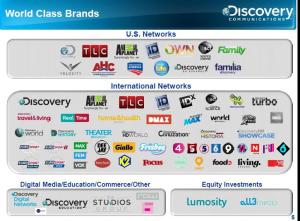
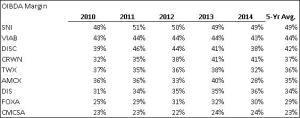
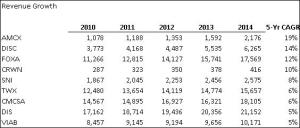
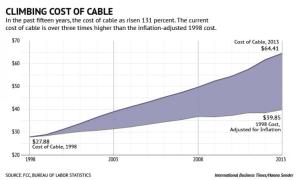
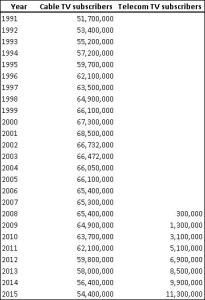
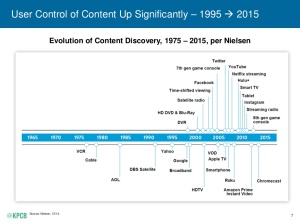
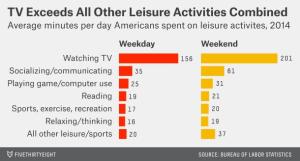
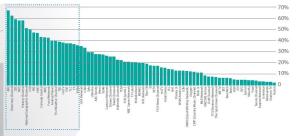
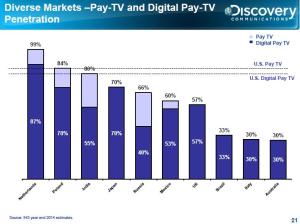
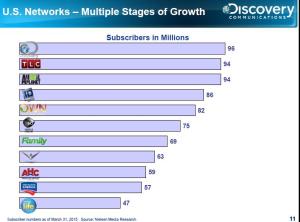
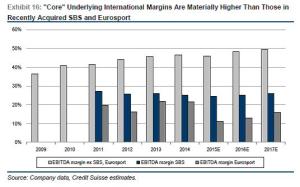
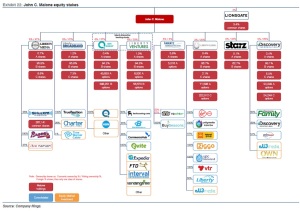
How are you arriving at a 21% OIBDA CAGR over the last 5 years?
Please note this refers to the International segment only. I pulled these numbers from the 10-Ks.
International Networks
Revenues: 2010 2011 2012 2013 2014 5Yr. CAGR
Distribution 778 890 984 1,242 1,553 19%
Advertising 422 514 580 1,162 1,483 37%
Other 51 51 54 70 121
Total revenues 1,251 1,455 1,618 2,474 3,157 26%
Costs of revenues, excluding depreciation and amortization (405) (455) (487) (881) (1,250) 33%
Selling, general and administrative (336) (397) (415) (640) (794) 24%
Mark-to-market share-based compensation
Restructuring and other charges (9) (3) (1) (11) (24) 28%
Gains on dispositions (2)
Inter-segment eliminations
OIBDA 501 600 715 942 1,087 21%
Sorry about the formatting. If you are interested, I can email you the spreadsheet.
It will be great if u can email me the spreadsheet too.
Thanks in advance
Thanks for the response, it would be great if you could share the spreadsheet.
Pingback: Some links | value and opportunity
Pingback: Charter: John Malone’s Return to The US Cable Industry | Punch Card Investing
Wait since when did paramount become a division of Sony?
Thanks for pointing this out, but why do you have to be obnoxious about it? Why don’t you put your analysis on view for the world to see, Nick?
I’m sorry I much enjoy the blog and it wasn’t my intent. I have not sniffed around these names in many years and I’m prone to self doubt so a tiny part of me was anticipating some unexpected transaction/partnership that I had missed.
Sorry, I over-reacted. I misinterpreted your comment.
Pingback: Blog post about Discovery Communications | Discovery Communications Review